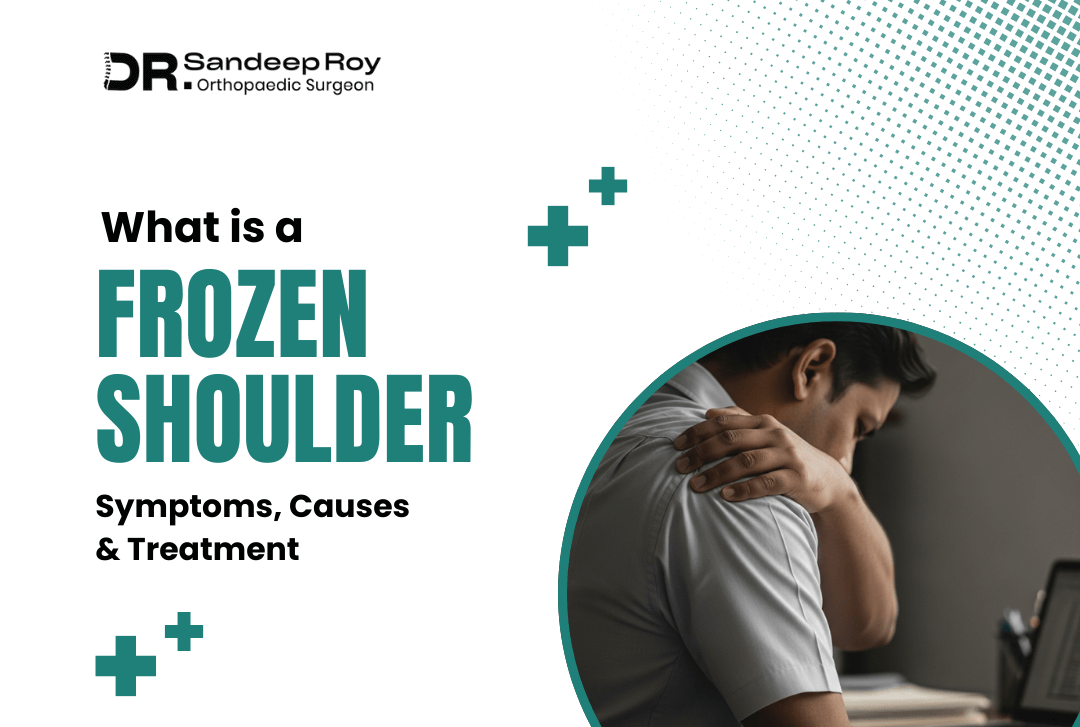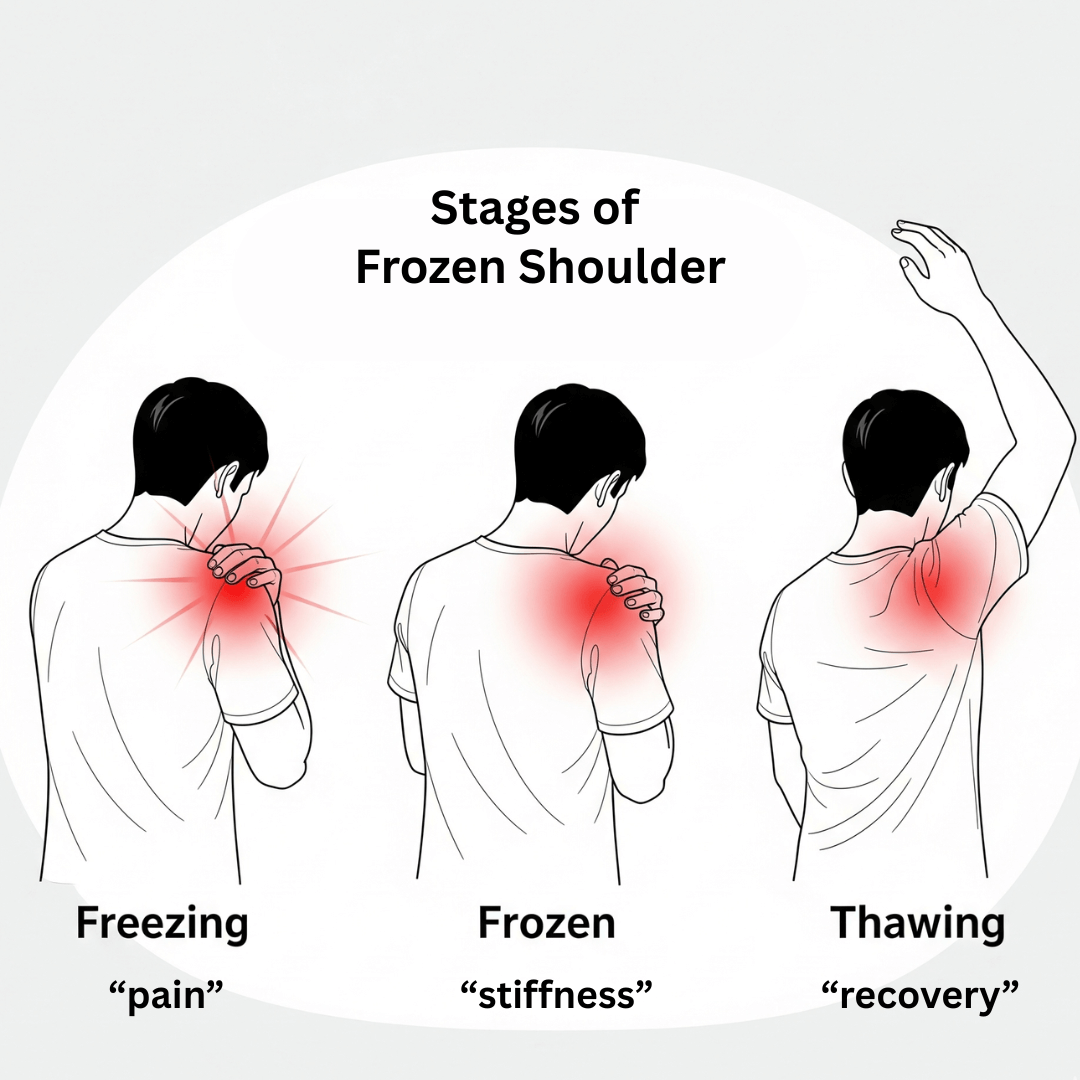Follow Us On

What is a Frozen Shoulder? Symptoms, Causes and Treatment
Ever tried to lift your arm and it feels like your shoulder just won’t move? Or maybe it moves a little, but with so much pain that you stop right there. That’s something people call frozen shoulder. The medical term is adhesive capsulitis, but honestly, “frozen shoulder” says it all, your shoulder feels stuck, stiff and painful, almost like it’s frozen in place.
What exactly is frozen shoulder?
It’s a condition where the tissues around your shoulder joint become thick and tight. Over time, scar tissue may form. This makes the shoulder hard to move, and even small movements can hurt a lot. It usually develops slowly and then sticks around for months (sometimes even years if not treated).

Symptoms to watch out for
Frozen shoulder often starts small and then gets worse:
- Pain: A dull, aching pain in your shoulder. Sometimes you also feel it in the upper arm.
- Stiffness: Your shoulder just doesn’t move like it used to. Lifting your arm, reaching behind, or even wearing a shirt can be a struggle.
- Limited movement: There are “phases.” At first, pain is the big problem. Later, stiffness becomes worse, and finally, slowly, the shoulder may “thaw” and movement comes back.
Most people describe it in 3 stages:
- Freezing stage – pain increases, movement becomes limited.
- Frozen stage – pain might reduce a little, but stiffness is at its worst.
- Thawing stage – movement starts to come back, slowly.

What causes frozen shoulder?
Now here’s the tricky thing, frozen shoulder doesn’t have one single cause that fits everyone. But there are certain situations and risk factors that make it more likely.
- Injury or surgery: Let’s say you had a shoulder fracture or underwent a joint replacement surgery, or you went through a surgery and your arm had to stay in a sling for weeks. Because the shoulder wasn’t moving much, the capsule around it can tighten up. It’s like if you don’t open a door for months, the hinges get rusty. The same thing happens inside your shoulder joint. Similar stiffness can also happen after certain sports injuries that affect the shoulder.
- Health conditions: Diabetes is the biggest link doctors see. People with diabetes are more likely to get frozen shoulder, and sometimes their recovery takes longer too. Other conditions like thyroid problems (both overactive and underactive), Parkinson’s disease, and even heart disease have been connected. The body’s metabolism and immune system play a role in how the shoulder heals or stiffens.
- Age and gender: Most patients between 40–60 years old are likely to suffer from this. Women seem to be affected more than men.
- Lifestyle and habits: If you live a very inactive lifestyle, or avoid moving your shoulder when it hurts, stiffness can worsen.
- Unknown reasons: And sometimes, it just appears without any clear trigger. A healthy person, no major injury, no illness, yet the shoulder gets stuck. That’s why it’s often frustrating, because people can’t point to “why?”
So overall, frozen shoulder is usually a mix of risk factors rather than one single cause.
Treatment – what can be done?
The good news is: frozen shoulder does get better in most people. The not-so-good news is: it takes time, and it requires patience. On average, recovery may take anywhere between 6 months to 2 years. But with the right treatment, most people get back full or near-full movement. Let’s break down the common treatment options:
- Physiotherapy and regular exercises: This is the number one treatment. Gentle stretching and movement exercises, when done consistently, help the shoulder “unfreeze.” A physiotherapist can show you safe techniques, and many of these can be continued at home too. The progress is slow, but every little bit of motion adds up over time.
- Heat therapy: Applying a warm compress or hot water bag before doing exercises helps relax the muscles and tissues around the joint. It makes stretching less painful and more effective.
- Cold packs (sometimes): During painful flare-ups, using an ice pack for 10–15 minutes can calm the shoulder down. Some people prefer heat, some cold — it depends on what feels soothing.
- Gentle daily movement: Avoid keeping the shoulder completely still. Try simple, pain-free movements during the day, even small things like reaching out slowly or using your other arm to guide the frozen one. This keeps the joint from stiffening more.
- Patience and consistency: Frozen shoulder doesn’t get fixed overnight. But with safe, regular care, most people regain movement over months. The key is not to give up when progress feels slow.
Commonly Advised Exercises
- Pendulum swing: Lean forward slightly and let the frozen arm hang down. Gently swing it in small circles.
- Wall climbing: Face a wall, and slowly walk your fingers up as high as you can go without sharp pain.
- Crossover stretch: Use your good arm to gently pull the frozen arm across your chest.
With the right care, your shoulder can move freely again, and life does get back to normal. Still, every case is not the same, for some it improves faster and for others it takes more time. The good thing is, it does get better but only if you give it proper care and little patience.
Doing safe exercises regular and keeping the shoulder moving helps a lot. But don’t try to manage it all alone for too long. If your pain or stiffness is not improving, its always better to reach out to a top orthopedic surgeon With right treatment and guidance, the shoulder slowly comes back to normal.


